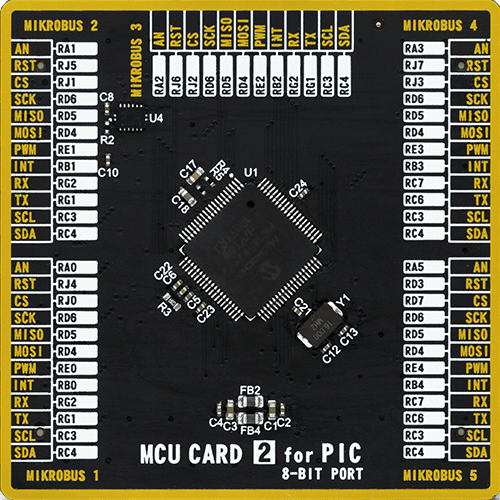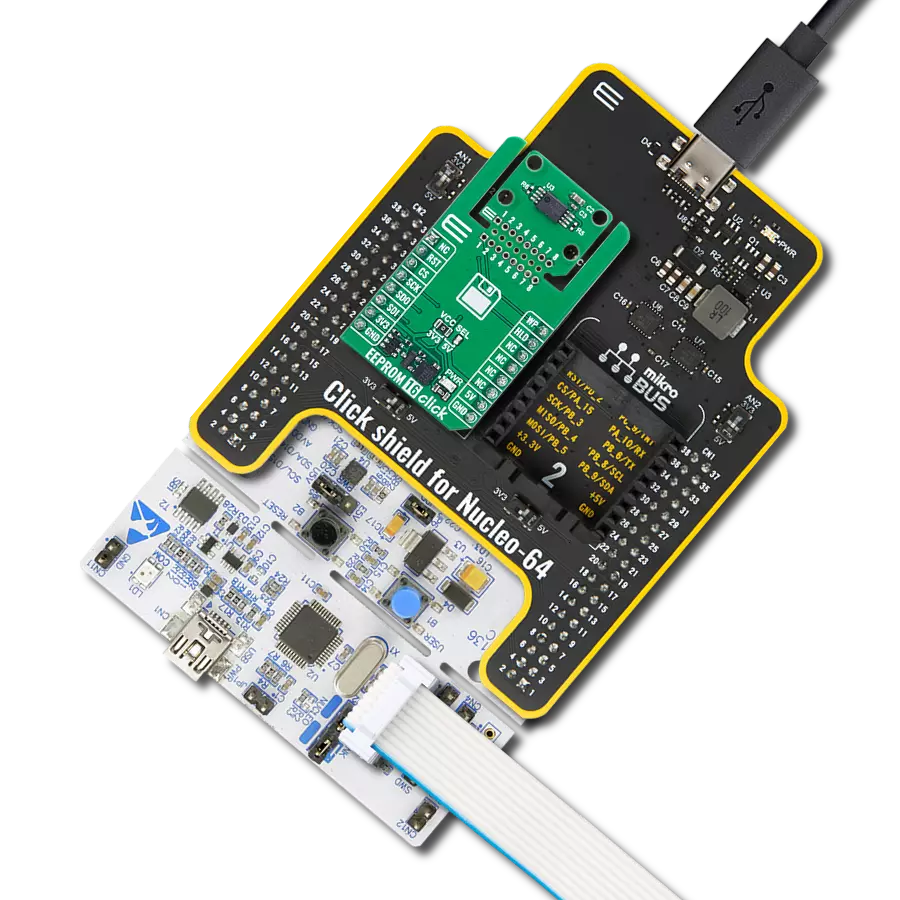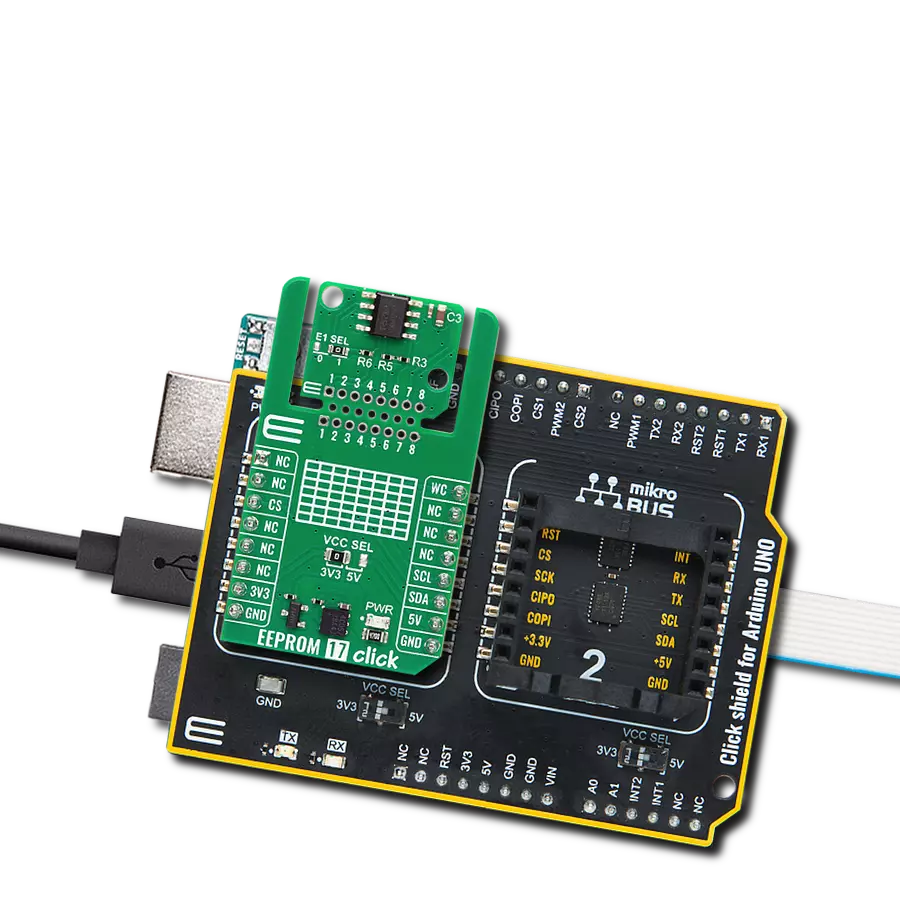Keep your data safe and secure in silicon for a century
A
A
Hardware Overview
How does it work?
EEPROM 8 Click is based on the CAV24C512, a 512-Kb EEPROM with an I2C interface and Write Protection Mode from ON Semiconductor. The CAV24C512 is organized as 65,536 words of 8 bits each and benefits from a wide power supply range and 100 years of data retention combining their unprecedented data storage with excellent energy efficiency. It is highly reliable, lasting one million full-memory read/write/erase cycles. On-chip Error Correction Code (ECC) makes this Click board™ suitable for high-reliability applications where dependable nonvolatile memory storage is essential.
This Click board™ communicates with MCU using the standard I2C 2-Wire interface that supports Standard (100 kHz), Fast (400 kHz), and Fast-Plus (1MHz) modes of operation. The CAV24C512 has a 7-bit slave address with the first five MSBs fixed to 1010. The address pins A0, A1, and A2 are programmed by the user and determine the value of the last three LSBs of the slave address, which can be selected by positioning onboard SMD jumpers labeled as ADDR SEL to an appropriate position marked as 0 or 1. Also, the configurable Write Protection function, the WP pin of the mikroBUS™
socket, allows the user to freeze the entire memory area, thus protecting it from Write instructions. This Click board™ can operate with either 3.3V or 5V logic voltage levels selected via the VCC SEL jumper. This way, both 3.3V and 5V capable MCUs can use the communication lines properly. However, the Click board™ comes equipped with a library containing easy-to-use functions and an example code that can be used, as a reference, for further development.



Features overview
Development board
UNI Clicker is a compact development board designed as a complete solution that brings the flexibility of add-on Click boards™ to your favorite microcontroller, making it a perfect starter kit for implementing your ideas. It supports a wide range of microcontrollers, such as different ARM, PIC32, dsPIC, PIC, and AVR from various vendors like Microchip, ST, NXP, and TI (regardless of their number of pins), four mikroBUS™ sockets for Click board™ connectivity, a USB connector, LED indicators, buttons, a debugger/programmer connector, and two 26-pin headers for interfacing with external electronics. Thanks to innovative manufacturing technology, it allows you to build
gadgets with unique functionalities and features quickly. Each part of the UNI Clicker development kit contains the components necessary for the most efficient operation of the same board. In addition to the possibility of choosing the UNI Clicker programming method, using a third-party programmer or CODEGRIP/mikroProg connected to onboard JTAG/SWD header, the UNI Clicker board also includes a clean and regulated power supply module for the development kit. It provides two ways of board-powering; through the USB Type-C (USB-C) connector, where onboard voltage regulators provide the appropriate voltage levels to each component on the board, or using a Li-Po/Li
Ion battery via an onboard battery connector. All communication methods that mikroBUS™ itself supports are on this board (plus USB HOST/DEVICE), including the well-established mikroBUS™ socket, a standardized socket for the MCU card (SiBRAIN standard), and several user-configurable buttons and LED indicators. UNI Clicker is an integral part of the Mikroe ecosystem, allowing you to create a new application in minutes. Natively supported by Mikroe software tools, it covers many aspects of prototyping thanks to a considerable number of different Click boards™ (over a thousand boards), the number of which is growing every day.
Microcontroller Overview
MCU Card / MCU

Type
8th Generation
Architecture
PIC
MCU Memory (KB)
96
Silicon Vendor
Microchip
Pin count
80
RAM (Bytes)
3936
Used MCU Pins
mikroBUS™ mapper
Take a closer look
Click board™ Schematic

Step by step
Project assembly
Software Support
Library Description
This library contains API for EEPROM 8 Click driver.
Key functions:
eeprom8_write_pageThis function writes up to 128 bytes of data starting from the selected register.eeprom8_read_random_byteThis function reads one byte data from the desired register.eeprom8_read_sequentialThis function reads the desired number of bytes starting from the selected register.
Open Source
Code example
The complete application code and a ready-to-use project are available through the NECTO Studio Package Manager for direct installation in the NECTO Studio. The application code can also be found on the MIKROE GitHub account.
/*!
* @file main.c
* @brief EEPROM8 Click example
*
* # Description
* This example demonstrates the use of EEPROM 8 Click board by writing specified data to
* the memory and reading it back.
*
* The demo application is composed of two sections :
*
* ## Application Init
* Initializes the driver and USB UART logging.
*
* ## Application Task
* Task writes a desired number of data bytes to the EEPROM 8 memory
* and verifies that it is written correctly by reading from the same memory location and
* in case of successful read, displays the memory content on the USB UART.
* This is done in two passes.
*
* @author Stefan Popovic
*
*/
#include "board.h"
#include "log.h"
#include "eeprom8.h"
static eeprom8_t eeprom8;
static log_t logger;
// Number of test bytes
#define TEST_NBYTES ( 150 )
// Starting address for example
#define TEST_MEM_LOCATION ( EEPROM8_BLOCK_ADDR_START + 1024ul )
static uint8_t cnt = 0;
static uint8_t test_write_buffer[ TEST_NBYTES ] = { 0 };
static uint8_t test_read_buffer[ TEST_NBYTES ] = { 0 };
static uint16_t addr_offset = TEST_MEM_LOCATION;
/**
* @brief First pass function
* @details This function writes and reads defined number of bytes
* with zero values
* @param[in] ctx Click object.
* @param[in] write_buf Data to be written.
* @param[out] read_buf Data to be read.
* @return @li @c 0 - Success,
* @li @c -1 - Error.
* See #err_t definition for detailed explanation.
* @note None.
*/
err_t run_first_pass( eeprom8_t* ctx, uint8_t* write_buf, uint8_t* read_buf );
/**
* @brief Second pass function
* @details This function writes and reads defined number of bytes
* with the values following arithmetical progression
* @param[in] ctx Click object.
* @param[in] write_buf Data to be written.
* @param[out] read_buf Data to be read.
* @return @li @c 0 - Success,
* @li @c -1 - Error.
* See #err_t definition for detailed explanation.
* @note None.
*/
err_t run_second_pass( eeprom8_t* ctx, uint8_t* write_buf, uint8_t* read_buf );
void application_init ( void )
{
eeprom8_cfg_t eeprom8_cfg; /**< Click config object. */
log_cfg_t log_cfg; /**< Logger config object. */
/**
* Logger initialization.
* Default baud rate: 115200
* Default log level: LOG_LEVEL_DEBUG
* @note If USB_UART_RX and USB_UART_TX
* are defined as HAL_PIN_NC, you will
* need to define them manually for log to work.
* See @b LOG_MAP_USB_UART macro definition for detailed explanation.
*/
LOG_MAP_USB_UART( log_cfg );
log_init( &logger, &log_cfg );
log_info( &logger, " Application Init " );
// Click initialization.
eeprom8_cfg_setup( &eeprom8_cfg );
EEPROM8_MAP_MIKROBUS( eeprom8_cfg, MIKROBUS_1 );
if ( I2C_MASTER_ERROR == eeprom8_init( &eeprom8, &eeprom8_cfg ) )
{
log_error( &logger, " Communication Init " );
for ( ; ; );
}
log_info( &logger, " Application Task " );
}
void application_task ( void )
{
// Reset variables
cnt = 0;
memset( test_read_buffer, 0, sizeof ( test_read_buffer ) );
addr_offset = TEST_MEM_LOCATION;
// Initiate first pass
// filling the eeprom addresses with zeros
if( EEPROM8_ERROR == run_first_pass( &eeprom8, test_write_buffer, test_read_buffer ) )
{
log_error( &logger, " First Pass Failed " );
}
// Initiate second pass
// filling the eeprom addresses with values following arithmetic sequence with difference of 1
if( EEPROM8_ERROR == run_second_pass( &eeprom8, test_write_buffer, test_read_buffer ) )
{
log_error( &logger, " Second Pass Failed " );
}
log_printf( &logger, " \r\nInitiating new iteration\r\n " );
// 6 seconds delay
Delay_ms ( 1000 );
Delay_ms ( 1000 );
Delay_ms ( 1000 );
Delay_ms ( 1000 );
Delay_ms ( 1000 );
Delay_ms ( 1000 );
}
int main ( void )
{
/* Do not remove this line or clock might not be set correctly. */
#ifdef PREINIT_SUPPORTED
preinit();
#endif
application_init( );
for ( ; ; )
{
application_task( );
}
return 0;
}
// First pass: writing zero values into eeprom memory and reading them back
err_t run_first_pass( eeprom8_t* ctx, uint8_t* write_buf, uint8_t* read_buf )
{
// Fill write buffer with zeros
memset( write_buf, 0, TEST_NBYTES );
// Fill whole page with zeros using page write operation
eeprom8_write_enable( ctx );
if ( EEPROM8_ERROR == eeprom8_write_page( ctx, addr_offset, write_buf ) )
{
log_error( &logger, " Write Page Failed " );
return EEPROM8_ERROR;
}
cnt += EEPROM8_NBYTES_PAGE;
// Fill remaining adresses with zero using byte write operation
addr_offset += EEPROM8_NBYTES_PAGE;
while( cnt < TEST_NBYTES )
{
if ( EEPROM8_ERROR == eeprom8_write_byte( ctx, addr_offset++, 0 ) )
{
log_error( &logger, " Write %d. Byte Failed ", ( uint16_t ) cnt );
return EEPROM8_ERROR;
}
cnt++;
Delay_10ms( );
}
eeprom8_write_protect( ctx );
Delay_1sec( );
// Read defined number of bytes starting from the test memory location
addr_offset = TEST_MEM_LOCATION;
if ( EEPROM8_ERROR == eeprom8_read_sequential( ctx, addr_offset, TEST_NBYTES, read_buf ) )
{
log_error( &logger, "Read Sequential Failed" );
return EEPROM8_ERROR;
}
// compare written and read buffers and log data in case of a match
if ( memcmp( write_buf, read_buf, sizeof( write_buf ) ) == 0 )
{
log_printf( &logger,
" \r\nFirst pass: reading %d bytes data starting from eeprom address 0x%x\r\n ",
( uint16_t ) TEST_NBYTES,
( uint32_t ) TEST_MEM_LOCATION );
for ( cnt = 0; cnt < TEST_NBYTES; cnt++ )
{
log_printf( &logger, " %d", ( uint16_t ) read_buf[ cnt ] );
Delay_ms ( 50 );
}
log_printf( &logger, "\r\n\r\n" );
}
else
{
return EEPROM8_ERROR;
}
return EEPROM8_OK;
}
// Second pass: writing incremental values into eeprom memory and reading them back
err_t run_second_pass( eeprom8_t* ctx, uint8_t* write_buf, uint8_t* read_buf )
{
for ( cnt = 0; cnt < TEST_NBYTES; cnt++ )
{
write_buf[ cnt ] = cnt + 1;
}
// Write buffer data using page write operation
cnt = 0;
eeprom8_write_enable( ctx );
if ( EEPROM8_ERROR == eeprom8_write_page( ctx, addr_offset, write_buf ) )
{
log_error( &logger, " Write Page Failed ");
return EEPROM8_ERROR;
}
cnt += EEPROM8_NBYTES_PAGE;
// Write remaining buffer data using byte write operation
addr_offset += EEPROM8_NBYTES_PAGE;
while ( cnt < TEST_NBYTES )
{
if ( EEPROM8_ERROR == eeprom8_write_byte( ctx, addr_offset++, write_buf[ cnt++ ] ) )
{
log_error( &logger, " Write %d. Byte Failed ", ( uint16_t ) cnt );
return EEPROM8_ERROR;
}
Delay_10ms( );
}
eeprom8_write_protect( ctx );
Delay_ms ( 1000 );
// Read bytes of the page size starting from the test memory location
addr_offset = TEST_MEM_LOCATION;
if ( EEPROM8_ERROR == eeprom8_read_sequential( ctx, addr_offset, EEPROM8_NBYTES_PAGE, read_buf ) )
{
log_error( &logger, " Read Sequential Failed " );
return EEPROM8_ERROR;
}
// Read two bytes with random byte read operation
addr_offset += EEPROM8_NBYTES_PAGE;
cnt = EEPROM8_NBYTES_PAGE;
if( EEPROM8_ERROR == eeprom8_read_random_byte( ctx, addr_offset, &read_buf[ cnt++ ] ) )
{
log_error( &logger, " Read %d. Random Byte Failed ", ( uint16_t ) cnt-1 );
return EEPROM8_ERROR;
}
++addr_offset;
if( EEPROM8_ERROR == eeprom8_read_random_byte( ctx, addr_offset, &read_buf[ cnt++ ] ) )
{
log_error( &logger, " Read %d. Random Byte Failed ", ( uint16_t ) cnt-1 );
return EEPROM8_ERROR;
}
// Read the rest of the bytes with current address read operation
while ( cnt < TEST_NBYTES )
{
if( EEPROM8_ERROR == eeprom8_read_current_byte( ctx, &read_buf[ cnt++ ] ) )
{
log_error( &logger, " Read %d. Current Byte Failed ", ( uint16_t ) cnt-1 );
return EEPROM8_ERROR;
}
}
// compare written and read buffers and log data in case of a match
if ( memcmp( write_buf, read_buf, TEST_NBYTES ) == 0 )
{
log_printf( &logger,
" \r\nSecond pass: reading %d bytes data starting from eeprom address 0x%x\r\n ",
( uint16_t ) TEST_NBYTES,
( uint32_t ) TEST_MEM_LOCATION );
for ( cnt = 0; cnt < TEST_NBYTES; cnt++ )
{
log_printf( &logger, " %d", ( uint16_t )read_buf[ cnt ] );
Delay_ms ( 50 );
}
log_printf( &logger, "\r\n\r\n" );
}
else
{
return EEPROM8_ERROR;
}
return EEPROM8_OK;
}
// ------------------------------------------------------------------------ END































